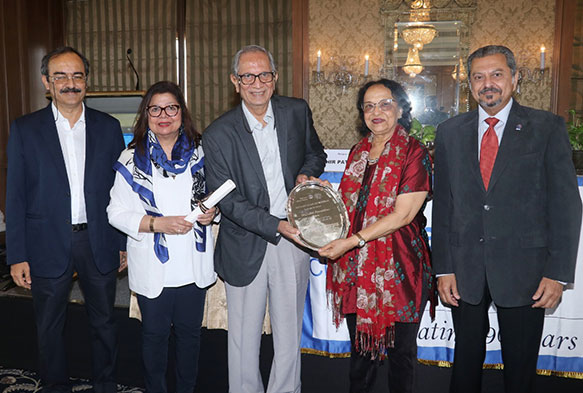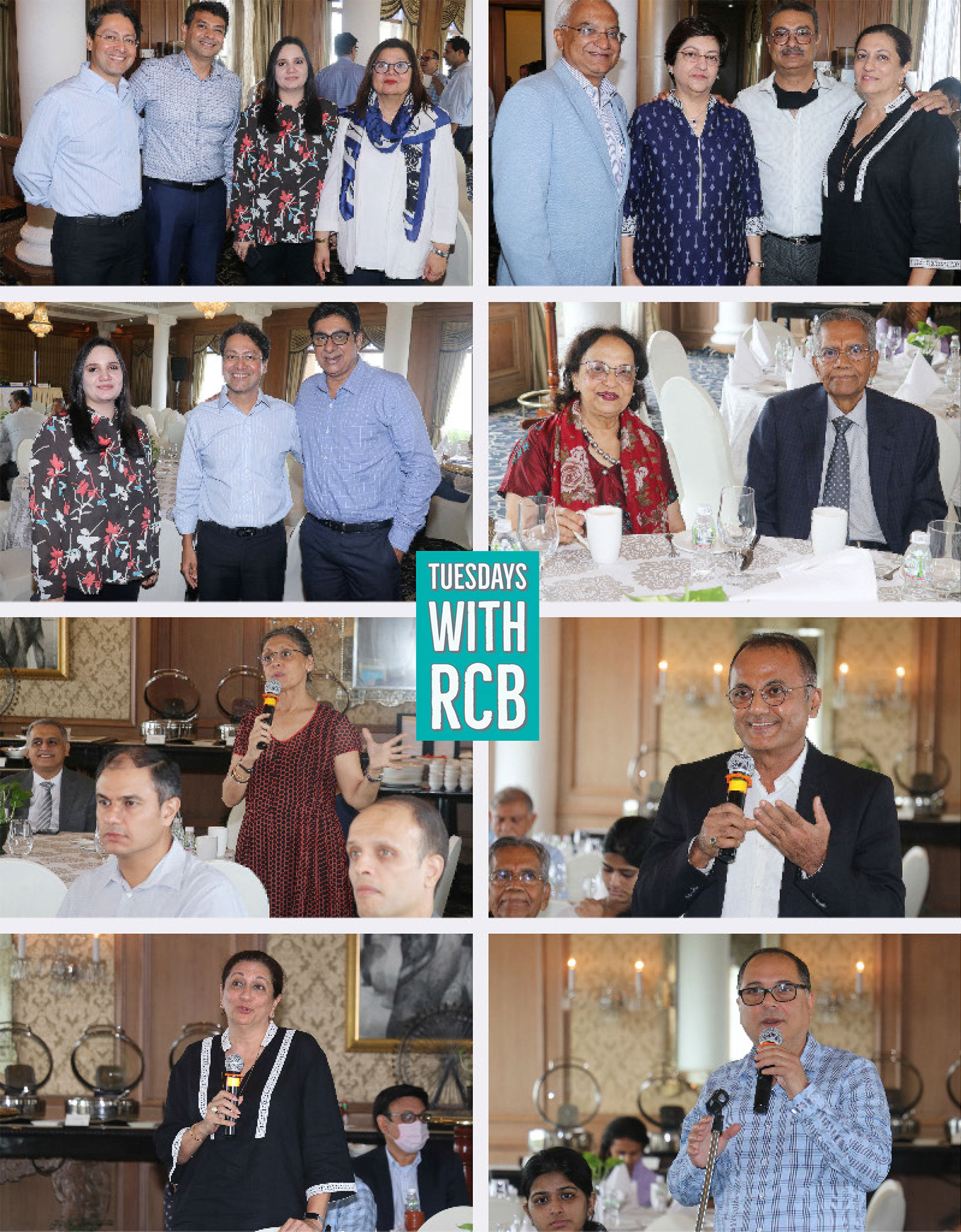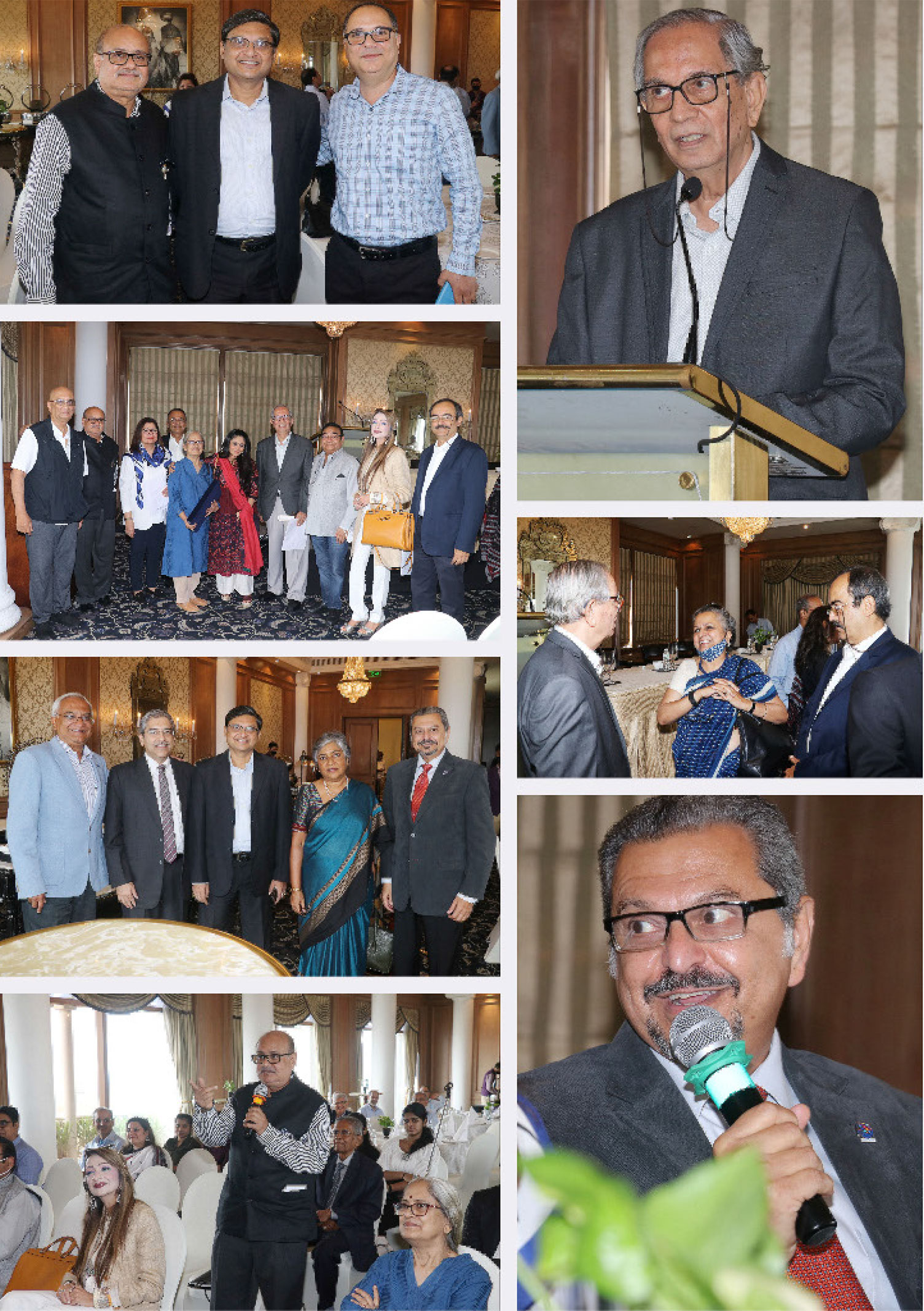
Rotary Club of Bombay presents the Shyam Munshi Lifetime Achievement in Arts Award to artist Sudhir Patwardhan
I have been painting for over 50 years. And I was a practicing radiologist for 30 years. I was fairly comfortable managing the two professions. And, I must say, lucky in both. Lucky in having good colleagues and staff as a radiologist, and lucky as an artist in having great artist friends and good gallerists. My first exhibition in 1979 was with the famed Ebrahim Alkazi’s Art Heritage Gallery in Delhi. And – hard to believe – the first buyers of my work were artists Krishen Khanna, M. F. Husain and Bal Chhabda. What could have been a greater honour and thrill for a young artist? You can’t get luckier than that.
Two years after my first exhibition, I was part of the hugely successful ‘Place for People’ exhibition, which set Indian art on a new trajectory of socially engaged art. An art that reflected the reality of a turbulent India in the ’70s and the ’80s. I had been painting large figurative paintings, street scenes and the like, and it would have been appropriate to continue in the same vein. But I had an inclination not to do the expected and I turned to landscape. For the next 10 years, I explored different ways to structure our perception of space, drawing from different traditions of Indian miniatures and Chinese painting.
But the call to paint the human figure was strong and for most of my career I have, in fact, been a painter of ordinary people – people I see in the streets, in trains, and all around me in the city of Bombay. I have been drawn to represent their lives on canvas. The question I have asked myself always is: How do I earn the right to speak about them? Though I may empathise with their life and struggles, it is not the life that I, myself, have lived – which is relatively privileged compared to theirs. The impulse to serve, in whatever way, those less fortunate than oneself, will be easily understood by Rotarians. For an artist it is important also to critically examine the source and nature of that impulse. A donation of money to the needy serves a purpose, no matter what the nature of the impulse behind the donation. In art, as in our spiritual life, a tainted impulse will fail to benefit the receiver as well as the giver.
As a painter, in answering this question of the right to speak for and about another, my experience as a doctor has come in handy. Both as a doctor and as a painter, I have a certain power, a certain influence, over my patients or the people I paint. I tell the patient what is good for him or her. And I show my subject what he or she looks like – what their life looks like. It is a responsibility that one assumes because your training and your position allow you to do so. But, like all power, this power can be misused. It can exploit the subject. How not to do that has been a key challenge for me as a painter. How to paint images that people can feel are a true reflection of their lives. How to express my insights into their lives without denying them their autonomy, their separate existence, their perspective? This has been an important question for me in panting people.
I have always dreamt of reaching a larger audience through my art. In an attempt to reach more people who may be interested in art but who do not get the opportunity to see good exhibitions, I have shown my own as well as other artist’s work outside the normal gallery circuit and in smaller cities. I have also shown my work in schools and factory sheds. In 2008-2009, with the help of Bodhi Art Gallery, I curated an exhibition of works by 30 important artists. We travelled for four months to eight cities, holding seminars, talks and film shows. The artists included F.N. Souza, Akbar Padamsee, Tyeb Mehta and V.S. Gaitonde; Bhupen Khakhar, Gulam Sheikh, Gieve Patel, Prabhakar Barve; Atul and Anju Dodiya, Harsha, Subodh Gupta, and Jitish Kallat and others. And the cities we showed in were Amravati, Nagpur, Aurangabad, Sholapur, Kolhapur, Pune, and Nashik. It was a very rewarding experience for us and is remembered as a landmark exhibition even today.
In recent years I have moved more to painting subjects of home and family. More personal subjects in which, I confess, one’s honesty is tested more keenly. Ageing has also been recurring subject in my work in recent years.
Along with these are the numerous questions that arise in the practice of art, in the actual act of painting and in thinking about painting. And these questions are always challenging and, in a sense, the most important to an artist. How does a representation relate to reality? How different or how similar is an abstract painting from a representational one? Painting what you see, painting what you remember, and painting what you imagine – how are they related? Or the technical question of how to manipulate perspective to represent the complex ways in which we perceive the city – standing, walking, travelling in the train, travelling by car? And, finally, the question – what makes a painting good? What makes it a thing of beauty that one wants to look at. And yet it is something that expresses a lived life, with all its conflicts, tribulations, and delights. Such questions are always on one’s mind. They are the ones that make being an artist interesting. Questions that have no final answers.
I have had the privilege of knowing great artists of the generation before mine, Akbar Padamsee and Tyeb Mehta. I learnt a great deal from them. Seeing them and their work and talking to them gave me a sense of the seriousness of this vocation and the difficulties of remaining on path. I have had the privilege of having close artist and writer friends in my own generation and, also, younger than me, with whom I can share my failures and successes. My greatest privilege has been to have been married to Shanta, also a doctor, and a dancer and teacher of dance, who has partnered me for 56 years. Given me perspective. It is to all these privileges that I owe this award.
ROTARIANS ASK
The sensitivity to actually understand your subject, to know what they are feeling, did this create your social impetus?
Yes. When in medical college, one starts to be exposed to the darker side of illnesses and tragedy. There is a time when one has to decide whether one wants to take an objective and unviewed view of this. You can also be a good doctor by being distanced but for me it was like getting involved and that is what led to me starting to paint and turning to art.
Did you ever feel handicapped about not being trained in art?
I do find it a handicap at times when I am setting out to do something and it is something that I haven’t been trained to do. But I don’t stress the self-taught part so much because I have learnt from different sources. I have learned from painters, books and seeing. So, you educate yourself as always.
I have seen your retrospective at NGMA and at Mahindra Headquarters. You draw inspiration from an urban milieu, empathise with the subjects; are any of your contemporaries doing the same work?
I think the generation of artists who matured in the ’70s and I came towards the end of ’70s but I already have the examples of this generation like Bhupen Khakhar, Ghulam Sheikh, Vivan Sundaram, Nalini Malani. At that time, there was this stir of looking at our reality. Before that, it was more idealised view of what Indian art should be because it went back to tradition and philosophy. Our generation thought it was important to look at the present and what is happening around. So, many painters are traditionally painting small cities, people and it continues. There are a lot of artists in Kerala, young artist painting these, Bengal Art scene has been urbanised. So, I think there is a strong tradition in Indian contemporary art towards this.
You said you like portraits, do you think the study of anatomy in medical college helped you to get some understanding in portraits?
I won’t say study of anatomy but becoming sensitive towards the subjects and what people are feeling behind their faces.
Have you been able to capture anything as far as the pandemic goes? How do you justify the obnoxious high price for abstract art?
It is difficult to answer as an artist, the market decides so many things for us, I don’t understand much of it. It is like everything else. In cars and pens, why would you pay a lakh for a fountain pen? Like that.
The pandemic did affect all of us, being cut off from the outside world, and being claustrophobia at home brought out certain subjects. Loneliness, how to handle that and at that time when you are painting, your memory takes you back to other times. There were things like that. There was a vision of these workers and people walking back from Bombay and cities, which was horrific. Anything that you paint will never capture the feel of it. I did express my sympathy to that condition.
Your comment on NFTs?
Frankly, I don’t understand what that thing is, and it doesn’t attract me. For me the physical surface of a painting is what I enjoy. One can see art digitally, but NFTs puzzle me.


